Thomas Lawrence of Bracknell (TLB)
Thomas Lawrence was a major player in brick making of the late 19th and early 20th century. He founded what became a huge and diverse business, not just in bricks but it is for bricks that he is perhaps most well known.
He was a draper in Binfield in 1847, then he became a tailor and later a hatter. In 1861 he had grocery and drapery businesses in Bracknell By 1877 he was agent for a bank and also for W&A Gilbey the wine & spirit merchant. Then he added printing, fancy stationers, home furnishing, ironmongery, earthenware china & glass to his interests. His empire grew further with a builders merchant, a timber merchant and steam sawmills. In 1907 Lawrence's Stores had 200 assistants, 3 acres of floor space and branches in Ascot, Yorktown and Camberley, with Wokingham & Crowthorne added before 1911.
 His company began making bricks in the 1860s and by 1893 had works at Swinley, Easthampstead, Warfield & Pinewood turning out 12 million bricks a year between them. During the previous year bricks bearing the distinctive TLB mark had been used in over 300 towns, in this country and abroad. Thomas Lawrence bricks were used by Madame Tussauds and Harrow College.
His company began making bricks in the 1860s and by 1893 had works at Swinley, Easthampstead, Warfield & Pinewood turning out 12 million bricks a year between them. During the previous year bricks bearing the distinctive TLB mark had been used in over 300 towns, in this country and abroad. Thomas Lawrence bricks were used by Madame Tussauds and Harrow College.
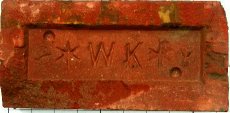 As well as hand pressed bricks marked TLB the company produced machine made bricks. They were made at his biggest works, at East Heath, off Molly Millar’s Lane, Wokingham.
As well as hand pressed bricks marked TLB the company produced machine made bricks. They were made at his biggest works, at East Heath, off Molly Millar’s Lane, Wokingham.
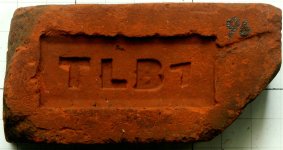
 Like many brick makers of the time, Thomas Lawrence produced a range of shaped bricks as well as standard bricks. From the known specimens it appears that each shape had a number that was included along with the TLB mark.
Like many brick makers of the time, Thomas Lawrence produced a range of shaped bricks as well as standard bricks. From the known specimens it appears that each shape had a number that was included along with the TLB mark.
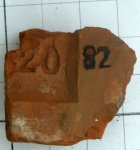 I first found a numbered fragment of a brick in the rubble under All Saints Church, Wokingham, dug out of a test pit. Most of the frog was missing and the only mark visible was '20', but given the location, and that the texture/colour were similar to TLB bricks I suspected it was, but I had no proof. A couple of years later I was given the shaped, numbered TLB bricks above, which made me more confident my hunch was correct.
I first found a numbered fragment of a brick in the rubble under All Saints Church, Wokingham, dug out of a test pit. Most of the frog was missing and the only mark visible was '20', but given the location, and that the texture/colour were similar to TLB bricks I suspected it was, but I had no proof. A couple of years later I was given the shaped, numbered TLB bricks above, which made me more confident my hunch was correct.
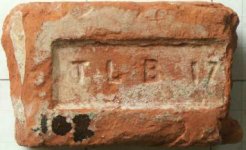 Then when the whole floor at the church was excavated during the 2022 renovation I found a much larger fragment marked 'TLB 17'. It wasn't quite a whole brick, and the ends are missing so I can't be sure whether or not it was shaped.
Then when the whole floor at the church was excavated during the 2022 renovation I found a much larger fragment marked 'TLB 17'. It wasn't quite a whole brick, and the ends are missing so I can't be sure whether or not it was shaped.
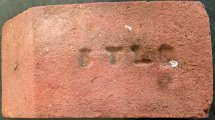 This brick, found with other TLB specimens is shaped in a different plane – the left hand end is sloping, so the near face is smaller than the rear face (170mm x 70mm compared with 250mm x 70mm). The marking is not distinct but appears to be '3 TLB'. Putting the number before the letters may have been an accident or it may have been a way to indicate that the shape was in a different plane.
This brick, found with other TLB specimens is shaped in a different plane – the left hand end is sloping, so the near face is smaller than the rear face (170mm x 70mm compared with 250mm x 70mm). The marking is not distinct but appears to be '3 TLB'. Putting the number before the letters may have been an accident or it may have been a way to indicate that the shape was in a different plane.
There were other large brickworks in the area, notably the Binfield Brick & Tile Company, but for many years Thomas Lawrence's business dominated not just brick making but business in general. Apparently someone in Bracknell once said: ‘You name it, TLB had it, from a packet of pins to a million bricks’.
But it didn't last, and the stores began to fail in the 1920s. Brickmaking survived into the mid 20th century but like many other traditional brickworks across the country the business must have been hit hard by competition from the London Brick Company flooding the market with cheap sand faced Flettons, and all the local brickworks eventually closed. The last to close were those making rubbers, which was a niche market, and Warfield finally closed in the 1970s.
Lawrence's biggest brickworks was at the Eastheath site, which produced 10 million bricks per year at its peak output south. It was south of Molly Millar’s Lane, Wokingham, and spread over 58 acres. There was a rail line into the site, which joined the Reading to Guildford line just south of where the line to Waterloo leaves it. The works closed in 1957 and the buildings, kilns and other plant were removed. For many years a large, 60’ deep pool remained. Known locally as The Blue Pool , it was filled in during the 1970s. The north of the site is now covered by housing and light industry, with the south of the site grassed over as recreational area as the Lesley Sears Playing Field and the Viking Field. Between them is a wooded earth bank, which is the only physical remnant of Wokingham's brick making industry.

Above: Old map showing part of the Eastheath works: Kilns at the top, Blue Lagoon in the centre
Reproduced under the Creative Commons Attribution-Non Commercial-Share Alike 4.0 International (CC-BY-NC-SA) licence.
Below: View west along the top of the bank in 2017
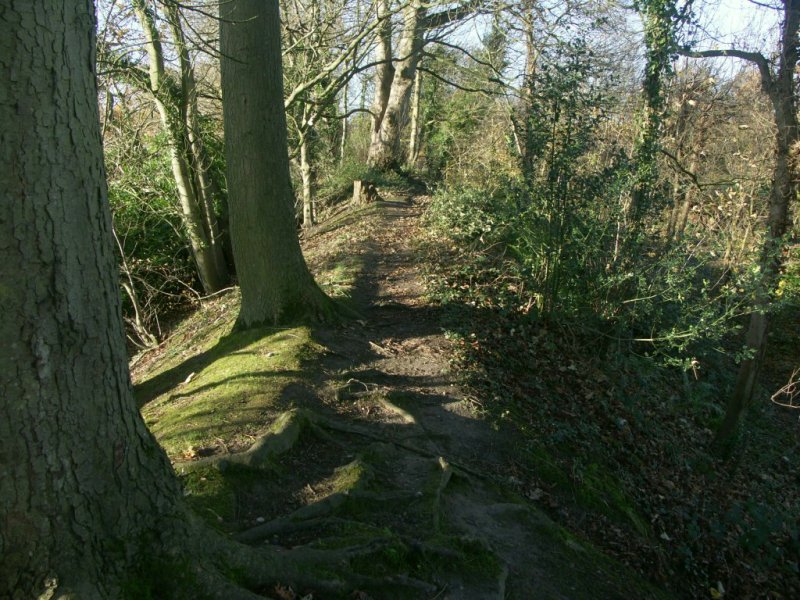
There are some pictures of Thomas Lawrence bricks in my brick collection .
Much of the information about the life of Thomas Lawrence comes from the booklet Brick Making: A Local Industry by MJ Dumbleton, published by Bracknell Historical Society.
 His company began making bricks in the 1860s and by 1893 had works at Swinley, Easthampstead, Warfield & Pinewood turning out 12 million bricks a year between them. During the previous year bricks bearing the distinctive TLB mark had been used in over 300 towns, in this country and abroad. Thomas Lawrence bricks were used by Madame Tussauds and Harrow College.
His company began making bricks in the 1860s and by 1893 had works at Swinley, Easthampstead, Warfield & Pinewood turning out 12 million bricks a year between them. During the previous year bricks bearing the distinctive TLB mark had been used in over 300 towns, in this country and abroad. Thomas Lawrence bricks were used by Madame Tussauds and Harrow College.  As well as hand pressed bricks marked TLB the company produced machine made bricks. They were made at his biggest works, at East Heath, off Molly Millar’s Lane, Wokingham.
As well as hand pressed bricks marked TLB the company produced machine made bricks. They were made at his biggest works, at East Heath, off Molly Millar’s Lane, Wokingham.
 Like many brick makers of the time, Thomas Lawrence produced a range of shaped bricks as well as standard bricks. From the known specimens it appears that each shape had a number that was included along with the TLB mark.
Like many brick makers of the time, Thomas Lawrence produced a range of shaped bricks as well as standard bricks. From the known specimens it appears that each shape had a number that was included along with the TLB mark.  I first found a numbered fragment of a brick in the rubble under All Saints Church, Wokingham, dug out of a test pit. Most of the frog was missing and the only mark visible was '20', but given the location, and that the texture/colour were similar to TLB bricks I suspected it was, but I had no proof. A couple of years later I was given the shaped, numbered TLB bricks above, which made me more confident my hunch was correct.
I first found a numbered fragment of a brick in the rubble under All Saints Church, Wokingham, dug out of a test pit. Most of the frog was missing and the only mark visible was '20', but given the location, and that the texture/colour were similar to TLB bricks I suspected it was, but I had no proof. A couple of years later I was given the shaped, numbered TLB bricks above, which made me more confident my hunch was correct.  Then when the whole floor at the church was excavated during the 2022 renovation I found a much larger fragment marked 'TLB 17'. It wasn't quite a whole brick, and the ends are missing so I can't be sure whether or not it was shaped.
Then when the whole floor at the church was excavated during the 2022 renovation I found a much larger fragment marked 'TLB 17'. It wasn't quite a whole brick, and the ends are missing so I can't be sure whether or not it was shaped. This brick, found with other TLB specimens is shaped in a different plane – the left hand end is sloping, so the near face is smaller than the rear face (170mm x 70mm compared with 250mm x 70mm). The marking is not distinct but appears to be '3 TLB'. Putting the number before the letters may have been an accident or it may have been a way to indicate that the shape was in a different plane.
This brick, found with other TLB specimens is shaped in a different plane – the left hand end is sloping, so the near face is smaller than the rear face (170mm x 70mm compared with 250mm x 70mm). The marking is not distinct but appears to be '3 TLB'. Putting the number before the letters may have been an accident or it may have been a way to indicate that the shape was in a different plane.
